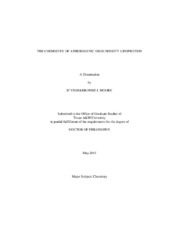| dc.description.abstract | An array of analytical methods including density gradient ultracentrifugation, capillary electrophoresis, and matrix-assisted laser desorption ionization mass spectrometry (MALDI-MS), were utilized to analyze serum high density lipoprotein (HDL) subfractions from two cohorts of normolipidemic individuals, which included subjects with diagnosed coronary artery disease (CAD), and angiographically proven non-CAD controls. These methods collectively provided characteristic information about the two populations of individuals including composition, electrophoretic mobilities, molecular weights, isoforms, and post-translational modifications of HDL apolipoproteins. This information proved useful in identifying potential biomarkers for CAD risk, and understanding the biological functions of a novel atherogenic HDL phenotype in individuals with CAD.
Through the implementation of the aforementioned methodologies, new isoforms of apoC-I were identified. MALDI-MS, detected a shifting of approximately 90 Da in the mass to charge ratios corresponding to apoC-I peaks in the serum subfractions from all CAD cohort patients. This shifting was not observed in the non-CAD cohort, which displayed apoC-I peaks in accordance with the known mass of this protein. In addition to the shifting observed in the CAD cohort, some CAD patients showed further modifications of apoC-I that were indicative of oxidative processes.
Interestingly, one patient, who has not been diagnosed with CAD, and has a family history of the disease, contained the apoC-I isoforms. This feature could underlie this subject’s known family history of CAD, and serve as an initial screening that could indicate the future development of CAD in this individual.
Through collaborative work with Johns Hopkins University, it was initially observed that apoC-I enriched HDL induced apoptosis of aortic smooth muscle cells. Conversely, apoC-I depleted HDL induced minimal to no apoptosis, which led to the hypothesis that apoC-I is a contributor to atherogenic HDL and is a potential risk factor for CAD. Further collaborative work with Johns Hopkins assessed the apoptosis levels induced by HDL from both cohorts of patients. A distinct difference in apoptosis was identified between the two cohorts. High density lipoprotein subfractions from subjects in the CAD cohort, all of which contained the apoC-I isoforms, induced marked apoptosis compared to the non-CAD controls. These results further supported the hypothesis that apoC-I compromises the functionality of HDL and showed that through the induction of apoptosis, apoC-I can contribute to the destabilization of atherosclerotic plaque and the acceleration of CAD. | en |


